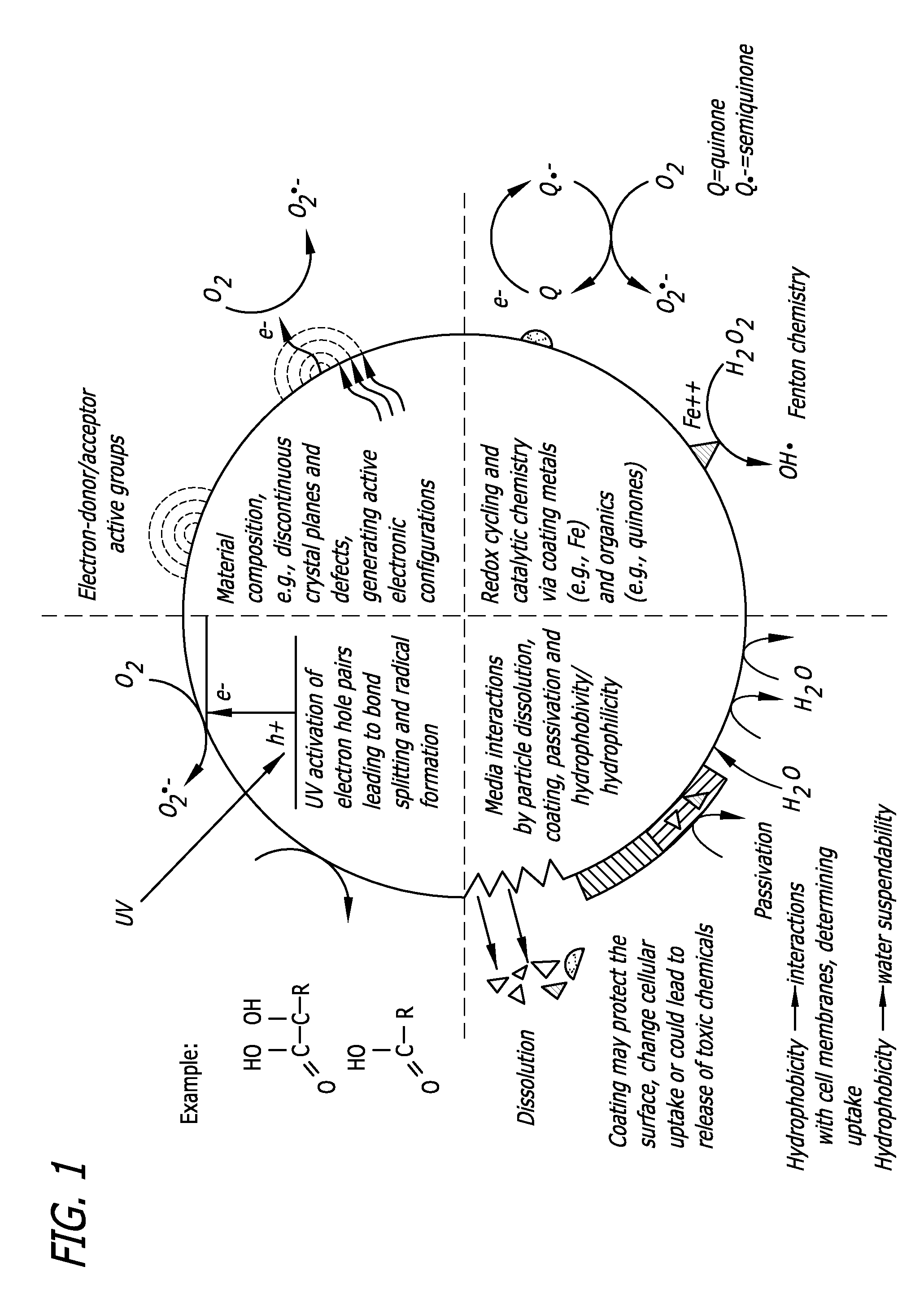Accessing the Toxic Potential of Nanomaterials
a technology of nanomaterials and toxic potential, which is applied in the field of detecting the toxic effect of nanoparticles and engineered nanomaterials, can solve the problems of limited data on manufactured particles, nm can exert toxic effects, and pose hazards to humans and the environmen
- Summary
- Abstract
- Description
- Claims
- Application Information
AI Technical Summary
Benefits of technology
Problems solved by technology
Method used
Image
Examples
example 1
Particle Selection and Physico-Chemical Characterization
[0070]Ambient UFP (<0.15 μm) were collected in the Los Angeles basin using the Versatile Aerosol Concentration Enrichment System (VACES) (Li N, et al., Eviron Health Perspect 111:455-60, 2003). The concentration enrichment process does not alter the physical, chemical, and morphologic properties of the particles. The particle concentration in the aqueous medium was calculated by dividing the particle loading by the total volume collected over that time period. The sample was collected at the University of Southern California (USC), which represents a typical urban site. The aerosols at this site are mostly generated from fresh vehicular emissions. The content of 16 signature polycyclic aromatic hydrocarbons (PAHs) in each collection was determined by HPLC-fluorescence. Heavy metal and other components were determined by Inductively Coupled Plasma Mass Spectroscopy (ICP-MS).
[0071]All nanoparticles were characterized in terms of ...
example 2
Assessment of ROS Generation Under Abiotic Conditions
[0082]A number of studies indicate that certain NPs exhibit the potential for spontaneous ROS generation based on material composition and surface characteristics. Examples include the presence of redox-cycling chemicals (UFP), crystallinity of the material surface and electronic configurations (TiO2), UV excitability (TiO2 and fullerol), and presence of a conjugated π-bond system (fullerol).
[0083]Two complementary techniques were used to assess ROS generation by the NP. The first uses the ROS quencher furfuryl alcohol (FFA) to measure the rate of oxygen consumption as an indirect indicator of the amounts that are being produced. The second assay uses a biosensor to measure H2O2 production.
[0084]ROS generation was assessed by the FFA assay of Pickering et al. (Environ. Sci. Technol. 39:1359-65, 2005). Four borosilicate glass vials with PTFE-lined caps were filled with a solution consisting of 100 mM fFFA in an aerated phosphate bu...
example 3
Induction of ROS Production in RAW 264.7 Cells
[0088]RAW 264.7 cells were cultured in a 5% CO2 in Dulbecco's Modified Eagle Medium (DMEM) containing 10% FCS, 5000 U / ml penicillin, 500 μg / ml streptomycin, and 2 mM L-glutamine (complete medium). For exposure to NP, aliquots of 3×105 cells were cultured in 24-well plates in 0.5 ml of medium at 37° C. for the indicated time periods. All the NP solutions were prepared fresh from stock solutions (10 mg / ml) and the solutions were sonicated for 10 sec before addition to cell cultures.
[0089]Cells were stained with the fluorescent dyes diluted in DMEM. The following dye combinations were added for 15-30 min at 37° C. in the dark: (i) 47.5 μg / ml propidium iodide (PI) in 200 μl DMEM (assessment of cell death); (ii) 20 nM DiOC6 (assessment of Δψm); (iii) 2 μM MitoSOX™ red (superoxide generation) or 2 μM hydroethidine (HE, superoxide production); (iv) 2.5 μM 2,7 dichlorofluorescein (DCF, mostly assesses H2O2 production); (v) 5 μM Fluo-3 (assess cy...
PUM
| Property | Measurement | Unit |
|---|---|---|
| period of time | aaaaa | aaaaa |
| period of time | aaaaa | aaaaa |
| aspect diameter | aaaaa | aaaaa |
Abstract
Description
Claims
Application Information
 Login to View More
Login to View More - R&D
- Intellectual Property
- Life Sciences
- Materials
- Tech Scout
- Unparalleled Data Quality
- Higher Quality Content
- 60% Fewer Hallucinations
Browse by: Latest US Patents, China's latest patents, Technical Efficacy Thesaurus, Application Domain, Technology Topic, Popular Technical Reports.
© 2025 PatSnap. All rights reserved.Legal|Privacy policy|Modern Slavery Act Transparency Statement|Sitemap|About US| Contact US: help@patsnap.com



